This Guide to Lean and Agile Methodologies aims to provide readers with a comprehensive understanding of both, including their origins, principles, and practical applications in project management and software development.
Throughout the guide, you can expect a solid understanding of Agile and Lean principles, and the difference between Agile and Lean, enabling them to make informed decisions about which approach best suits their project or organization’s needs and how to effectively implement it for improved efficiency, productivity, and customer satisfaction.
Introduction
Brief Overview
Lean and Agile methodologies are two prominent approaches revolutionizing project management and software development.
Lean, originating from Toyota’s manufacturing practices, focuses on eliminating waste, optimizing processes, and delivering maximum value to customers. Agile, born out of the software development industry, emphasizes adaptability, collaboration, and iterative development to quickly respond to changing requirements.
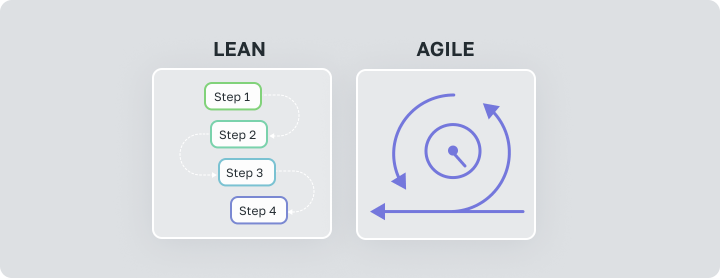
While Lean aims to streamline operations through continuous improvement and waste reduction, Agile prioritizes customer feedback and flexibility in project execution.
Both methodologies share common principles, such as empowering teams, promoting transparency, and fostering a culture of continuous learning.
Understanding the nuances, applications, and differences between Agile and Lean methodologies is essential for organizations seeking to enhance efficiency, innovation, and customer satisfaction in today’s dynamic business landscape.
Historical Context
Let’s start with the Lean methodology. Picture a car assembly line: Lean principles originated from Toyota’s manufacturing process in the 1950s. It’s like tidying up your workspace — eliminating waste, improving efficiency, and focusing on continuous improvement.
Now, Agile methodology emerged in the software development world in the 1990s. Think of it as building a house: Agile breaks down big projects into smaller, manageable chunks. It’s all about flexibility and collaboration, like adapting blueprints as you go.
Both Agile and Lean share common goals: delivering value to customers quickly and efficiently, while staying adaptable to change. So whether you’re streamlining a production line or developing software, these methodologies help teams work smarter and achieve better results!
Understanding Lean Methodology
Core Principles of Lean
To break down the core principles of Lean in simple terms, please consider:

- Value: Imagine making a sandwich. Lean says focus on what the customer wants — maybe it’s the perfect ratio of ingredients. Everything else is just extra mayo!
- Value Stream: Think of a river flowing from raw materials to the finished product. Lean maps out this flow, finding ways to make it smoother, like removing rocks from a stream.
- Flow: Picture traffic on a highway. Lean aims for a steady flow of work, minimizing stops and starts, just like avoiding rush hour jams.
- Pull: Ever been to a buffet? Lean says only make what’s needed when it’s needed. It’s like cooking more pancakes as people ask for them.
- Perfection: Think of a chef always improving their recipe. Lean encourages continuous improvement, striving for perfection in every aspect, big or small.
Lean in Practice: Case Studies and Examples
There are some real-world examples showcasing Lean methodology across different industries:
- Toyota Production System (TPS): Toyota revolutionized car manufacturing with Lean principles. By empowering workers to identify and solve problems, they cut waste and improved efficiency. For instance, workers on the assembly line could stop production if they noticed a defect, ensuring quality at every step.
- Amazon’s Fulfillment Centers: In the IT and logistics sector, Amazon applies Lean to optimize its fulfillment processes. By utilizing data analytics to forecast demand, they can adjust inventory levels and minimize storage costs. Their emphasis on continuous improvement led to innovations like robots aiding in order picking, reducing time and labor.
- Construction Industry: Lean principles are transforming the construction industry too. Companies like DPR Construction use Lean techniques to streamline project schedules, reduce material waste, and enhance collaboration among contractors. Prefabrication of building components off-site minimizes on-site work and speeds up construction, saving time and resources.
Benefits and Challenges of Implementing Lean
Implementing Lean practices offers numerous benefits, including increased efficiency, reduced waste, improved quality, and enhanced customer satisfaction. By streamlining processes and eliminating non-value-added activities, organizations can achieve cost savings and higher productivity. Additionally, Lean fosters a culture of continuous improvement, empowering employees to identify and address problems proactively, leading to innovation and growth.
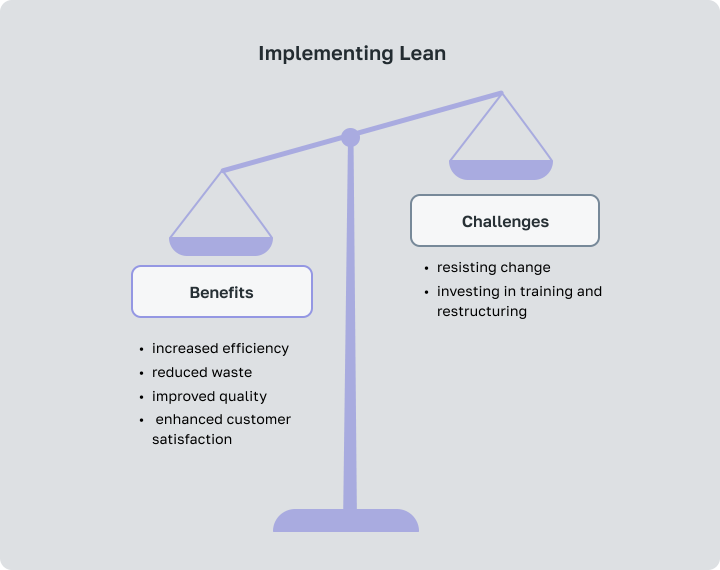
However, adopting Lean methodologies comes with its own set of challenges. One major obstacle is resistance to change, as employees may be accustomed to existing workflows and reluctant to embrace new practices. Moreover, implementing Lean requires significant investment in training and restructuring, which can strain resources and disrupt operations in the short term.
Despite these challenges, the potential benefits of Lean make it a worthwhile endeavor for organizations seeking to optimize their processes and drive sustainable growth.
Exploring Agile Methodology
Agile Manifesto and Core Values
The Agile Manifesto, created in 2001 by a group of software developers seeking more flexible and adaptive approaches to project management, outlines four key values and twelve principles that underpin Agile methodology.
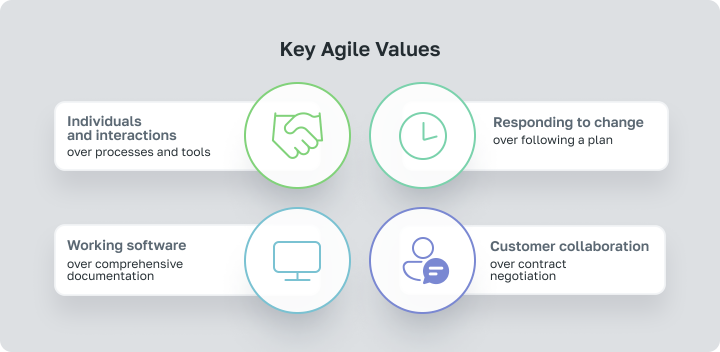
- Individuals and interactions over processes and tools: Agile prioritizes the human element, emphasizing collaboration, communication, and teamwork over rigid procedures or reliance on technology.
- Working software over comprehensive documentation: Instead of extensive documentation, Agile values tangible results. It encourages frequent delivery of functioning software, allowing for rapid feedback and adaptation.
- Customer collaboration over contract negotiation: Agile emphasizes active involvement of customers and stakeholders throughout the development process. By engaging users early and often, teams can ensure that the final product meets their needs and expectations.
- Responding to change over following a plan: Agile embraces change as a natural part of the development process. Rather than adhering strictly to a predetermined plan, teams remain flexible and responsive to evolving requirements and feedback.
Agile in Action: Real-World Applications
Agile methodologies are widely applied across various industries, including IT, production, and architecture, to drive innovation, improve efficiency, and enhance collaboration.
- Software Development: Companies like Spotify and Netflix leverage Agile practices to deliver frequent updates and new features, responding swiftly to changing market demands and user feedback. Cross-functional teams work in short, iterative cycles called sprints, ensuring rapid development and continuous improvement.
- Manufacturing: Agile principles are increasingly adopted in production settings to optimize workflows and reduce time-to-market. For example, General Electric implemented Agile in its appliance division, enabling teams to adapt quickly to changing customer preferences and market trends, resulting in faster product launches and improved quality.
- Architecture and Construction: Architectural firms like ZGF Architects embrace Agile methodologies to streamline project management and enhance collaboration among designers, engineers, and clients. By breaking down complex projects into smaller, manageable tasks and involving stakeholders throughout the process, teams can deliver innovative designs that meet client expectations within tight deadlines and budgets.
Advantages and Limitations of Agile
Agile methodology offers several advantages, including enhanced flexibility, faster time-to-market, improved collaboration, and increased customer satisfaction. By breaking down projects into smaller, manageable iterations, Agile enables teams to adapt quickly to changing requirements and priorities, reducing the risk of project failure and ensuring alignment with customer needs.
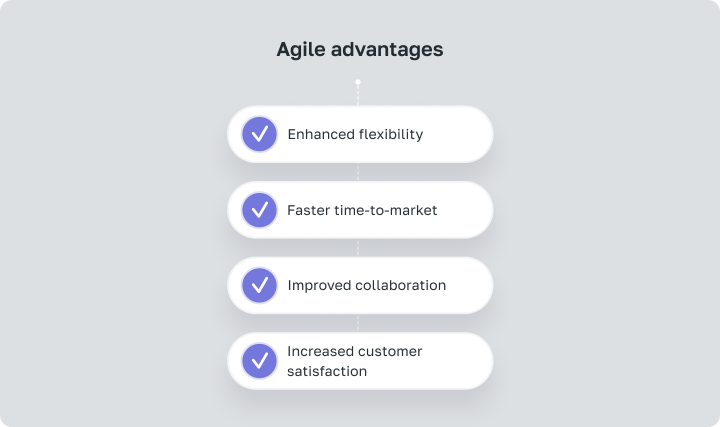
Moreover, the iterative nature of Agile allows for frequent feedback loops, enabling continuous improvement and innovation throughout the development process. Additionally, Agile fosters a culture of transparency, accountability, and teamwork, empowering cross-functional teams to take ownership of their work and collaborate effectively towards common goals.
However, Agile also has its limitations. One challenge is the potential for scope creep, as stakeholders may request additional features or changes during the development process, leading to scope changes and timeline extensions. Moreover, Agile requires a high level of discipline and collaboration among team members, which can be difficult to maintain, especially in larger or distributed teams.
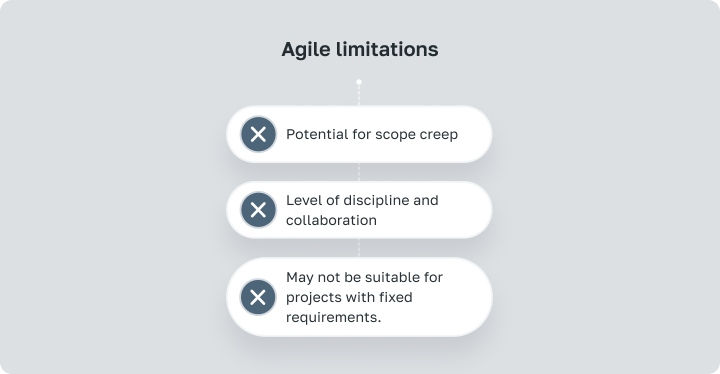
Additionally, Agile may not be suitable for projects with fixed requirements or strict regulatory constraints, as the emphasis on flexibility and adaptability may conflict with these requirements. Furthermore, transitioning to Agile may require significant cultural and organizational changes, which can be disruptive and challenging to implement effectively.
Despite these limitations, Agile remains a popular and effective methodology for many organizations seeking to deliver value to customers quickly and efficiently.
Comparative Analysis: Lean vs. Agile
Key Similarities
Lean and Agile methodologies share several key similarities, despite originating in different contexts and industries:
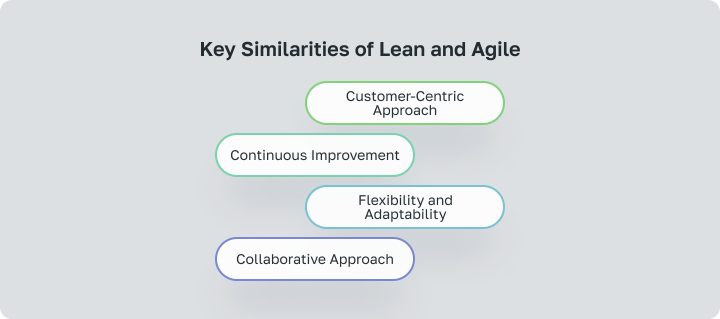
- Customer-Centric Approach: Both Agile and Lean prioritize delivering value to the customer efficiently and effectively. They emphasize understanding customer needs, incorporating feedback, and focusing on delivering high-quality products or services that meet customer expectations.
- Continuous Improvement: Both Agile and Lean methodologies advocate for continuous improvement and adaptation. Lean promotes a culture of continuous improvement through waste reduction and process optimization, while Agile encourages iterative development and frequent feedback loops to refine and enhance the product or service over time.
- Flexibility and Adaptability: Agile and Lean are both characterized by their flexibility and adaptability to change. Lean principles enable organizations to respond quickly to changes in demand or market conditions, while Agile methodologies allow teams to adapt to evolving requirements and priorities throughout the development process.
- Collaborative Approach: Both Agile and Lean emphasize collaboration and teamwork. Lean encourages cross-functional collaboration and problem-solving to optimize processes and drive improvements, while Agile promotes collaboration among team members, stakeholders, and customers to deliver value and achieve project goals.
Fundamental Differences
While Agile and Lean methodologies share common principles and goals, they also exhibit fundamental differences in their principles and practices:
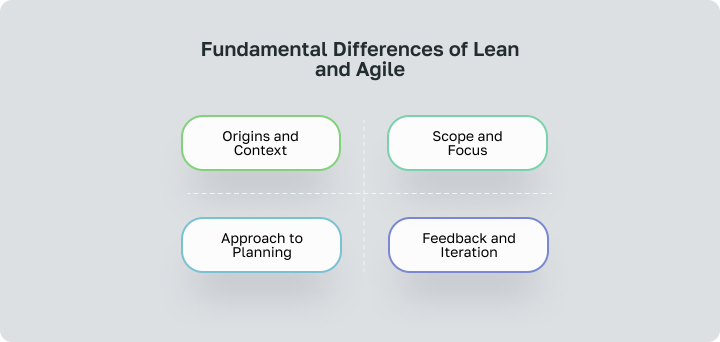
- Origins and Context: Lean originated in manufacturing, specifically from Toyota’s production system, focusing on eliminating waste and optimizing processes. In contrast, Agile emerged in the software development industry, prioritizing flexibility, adaptability, and customer collaboration.
- Scope and Focus: Lean primarily concentrates on optimizing processes and reducing waste across the entire value stream, aiming for efficiency and continuous improvement in all aspects of the organization. Agile, on the other hand, focuses on iterative development and delivery of value-added features, with a primary emphasis on satisfying customer needs and responding to change.
- Approach to Planning: Lean typically follows a more structured and long-term planning approach, aiming for stable and predictable processes to minimize variation and waste. Agile, however, embraces change and uncertainty, favoring short-term planning through iterative cycles of development and adaptation to evolving requirements.
- Feedback and Iteration: While both Lean Agile mindset and principles emphasize feedback and iteration, they differ in their frequency and timing. Lean tends to incorporate feedback at various stages of the value stream to drive continuous improvement, whereas Agile places a strong emphasis on frequent feedback loops within short development iterations to refine and improve the product or service incrementally.
Decision-Making: When to Use Which
When deciding between Agile and Lean methodologies, it’s crucial to consider the specific needs, goals, and characteristics of the project:
- Project Type and Complexity: For projects with well-defined requirements and stable processes, Lean may be more suitable, as it emphasizes efficiency, waste reduction, and long-term optimization. Agile, on the other hand, is better suited for projects with high levels of uncertainty, complexity, and rapidly changing requirements.
- Customer Involvement and Feedback: If the project requires frequent customer involvement and feedback to refine and validate product features, Agile is often the preferred choice due to its iterative development approach and emphasis on customer collaboration. Lean may be more appropriate for projects where customer requirements are relatively stable, and feedback loops are less critical.
- Time-to-Market and Speed of Delivery: Agile is well-suited for projects with short time-to-market requirements or where rapid delivery of incremental value is essential. Lean can also be effective in accelerating time-to-market by optimizing processes and reducing waste, but it may not provide the same level of flexibility and responsiveness as Agile.
- Team Size and Structure: Agile methodologies are highly collaborative and work well for small to medium-sized cross-functional teams, whereas Lean principles can be applied across larger organizational structures to drive efficiency and continuous improvement at scale.
Integrating Lean and Agile Approaches
Synergies and Strategies
Integrating Agile and Lean methodologies can create synergies that leverage the strengths of both approaches, leading to more effective and efficient project outcomes. Here are some strategies for integrating Lean and Agile:
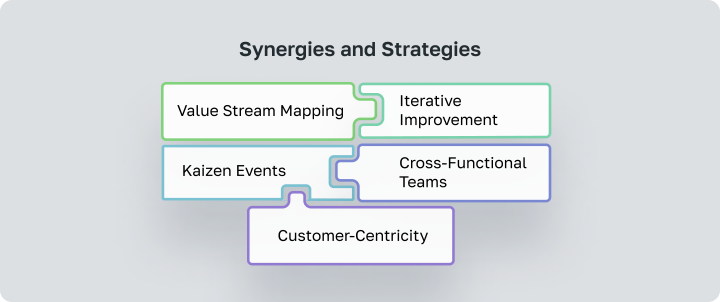
- Value Stream Mapping: Use Lean’s value stream mapping techniques to identify waste and bottlenecks in processes. This can help Agile teams prioritize improvements and streamline workflows for faster delivery.
- Iterative Improvement: Apply Agile’s iterative approach to continuous improvement within Lean processes. By breaking down improvement initiatives into smaller, manageable iterations, teams can test and implement changes more quickly, leading to incremental gains in efficiency and quality.
- Kaizen Events: Incorporate Agile principles into Lean’s kaizen events, which are focused improvement workshops. By adopting Agile practices such as daily stand-ups, sprint planning, and retrospectives, teams can enhance collaboration, communication, and problem-solving during kaizen events.
- Cross-Functional Teams: Build cross-functional teams that combine the expertise of Lean practitioners and Agile specialists. This allows for a holistic approach to process improvement, with a focus on both efficiency and adaptability.
- Customer-Centricity: Emphasize customer-centricity by integrating Lean’s focus on value delivery with Agile’s customer collaboration and feedback loops. This ensures that improvement efforts are aligned with customer needs and priorities, driving greater satisfaction and value creation.
Appropriate project management software such as Worksection can facilitate the integration of Lean and Agile methodologies by providing tools and features that support collaboration, transparency, and efficiency. The most essential Worksection tools include Task Management, Gantt charts, Collaboration Features, Reporting and Analytics. Worksection is a perfect solution for Agile teams. Empower your work with effective project planning and management with Worksection and a 14-day free trial.
Success Stories
One notable success story of integrating Agile and Lean methodologies comes from Spotify, the music streaming service. Spotify adopted a unique approach called “Squads, Tribes, Chapters, and Guilds” to blend Lean and Agile practices seamlessly. In this model, Agile Squads, which are small, cross-functional teams, work independently on specific features or components of the product. These Squads operate within larger Tribes, which are groups of Squads aligned around a common mission or goal. Chapters and Guilds provide additional support and expertise, fostering collaboration and knowledge sharing across Squads and Tribes.
This integration of Lean principles, such as minimizing waste and optimizing processes, with Agile practices, such as iterative development and customer focus, has enabled Spotify to rapidly innovate and deliver new features to its users. The company’s success in scaling Agile practices across its organization while maintaining a lean and adaptive culture has made it a prominent example of effective Lean-Agile integration in action.
Another example is General Electric (GE), which successfully applied Lean and Agile methodologies in its appliance division. By implementing Agile practices like Scrum and Kanban alongside Lean principles of waste reduction and value stream mapping, GE was able to streamline its production processes, reduce time-to-market, and improve product quality. This integration of Lean and Agile methodologies helped GE achieve significant cost savings and competitive advantages in the highly competitive appliance market.
Future Trends in Lean and Agile
Emerging Trends
As Agile and Lean methodologies continue to evolve, several emerging trends are shaping their future direction:
- Scaled Agile Frameworks (SAFe): Organizations are increasingly adopting scaled Agile frameworks like SAFe to apply Agile principles at the enterprise level. SAFe provides a structured approach for coordinating Agile teams across large organizations, enabling alignment, collaboration, and faster delivery of value.
- Lean Portfolio Management (LPM): LPM is gaining traction as a way to apply Lean principles to portfolio management, aligning investment decisions with strategic objectives and maximizing value delivery. By optimizing the flow of value through the portfolio, organizations can prioritize initiatives, minimize waste, and enhance overall performance.
- Agile in Non-Software Environments: Agile methodologies are expanding beyond the realm of software development to other industries such as marketing, HR, and finance. This trend reflects the growing recognition of Agile’s applicability in diverse contexts and its potential to drive innovation and adaptability across various business functions.
- DevOps Integration: The integration of DevOps practices with Agile and Lean methodologies is becoming increasingly prevalent, as organizations seek to streamline the software development lifecycle and improve collaboration between development and operations teams. DevOps complements Agile and Lean by automating processes, accelerating delivery, and enhancing overall efficiency and quality.
Predictions for Various Industries
In the future, Lean and Agile methodologies are expected to have a profound impact across various industries:- Digital Production: Lean principles will drive efficiency improvements in digital production processes, helping companies streamline workflows, reduce waste, and optimize resource utilization. By eliminating non-value-added activities and focusing on delivering high-quality digital products, organizations can accelerate time-to-market and enhance customer satisfaction.
- Retail: Lean practices will help retailers streamline supply chains, reduce inventory costs, and enhance customer satisfaction through improved product availability and faster order fulfillment. Agile approaches will enable retailers to respond quickly to changing consumer preferences, innovate new products and services, and deliver seamless omnichannel experiences.
- Education: Lean principles will enable educational institutions to optimize administrative processes, improve student outcomes, and enhance the overall learning experience. Agile methodologies will support the development of adaptive learning solutions, personalized curricula, and collaborative teaching methods, empowering educators to meet the diverse needs of students in a rapidly evolving digital landscape.
- Finance: Lean and Agile methodologies will revolutionize financial services by driving process automation, enhancing risk management, and improving customer engagement. Agile practices will enable financial institutions to develop innovative fintech solutions, such as digital banking platforms and algorithmic trading systems, to deliver personalized financial services and drive business growth.
Adapting to Change
To adapt Lean and Agile methodologies to changing business environments, organizations can implement the following strategies:
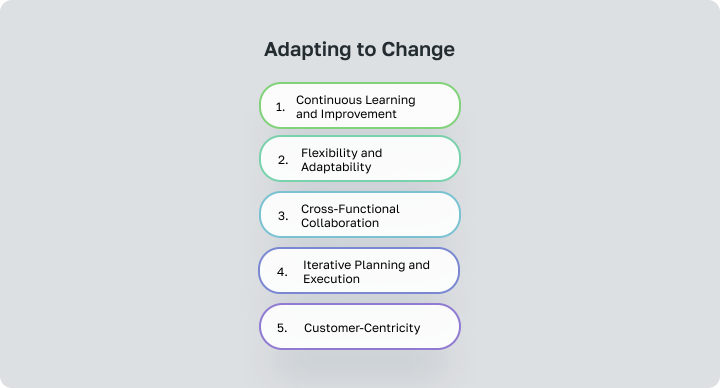
- Continuous Learning and Improvement: Foster a culture of continuous learning and improvement by encouraging experimentation, feedback, and reflection.
- Flexibility and Adaptability: Encourage teams to be responsive to changing market conditions, customer needs, and technological advancements.
- Cross-Functional Collaboration: Promote cross-functional collaboration and communication among teams, departments, and stakeholders.
- Iterative Planning and Execution: Adopt an iterative approach to planning and execution, where projects are broken down into small, manageable increments and delivered iteratively.
- Customer-Centricity: Prioritize customer-centricity in all aspects of the organization, from product development to service delivery.
Conclusion
Summary of Key Takeaways
- Lean focuses on efficiency, waste reduction, and continuous improvement, while Agile prioritizes flexibility, collaboration, and customer value.
- Integrating Lean and Agile methodologies can drive innovation, efficiency, and customer satisfaction.
- Project management software aids in combining Lean and Agile practices effectively.
- Emerging trends include scaled Agile frameworks, Lean portfolio management, and Agile in non-software industries.
- Lean and Agile will impact various sectors, fostering continuous learning, flexibility, and customer-centricity to thrive in changing business environments.
Final Thoughts
In conclusion, Lean and Agile methodologies are powerful frameworks that empower organizations to adapt, innovate, and thrive in today’s fast-paced and competitive business landscape.
By embracing Lean’s focus on efficiency and waste reduction and Agile’s emphasis on flexibility and customer value, organizations can deliver high-quality products and services that meet customer needs and drive business success.
Through continuous learning, collaboration, and adaptation, Lean and Agile enable organizations to stay ahead of the curve, respond effectively to change, and achieve sustainable growth in an ever-evolving world.
